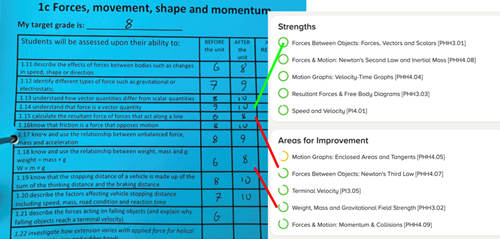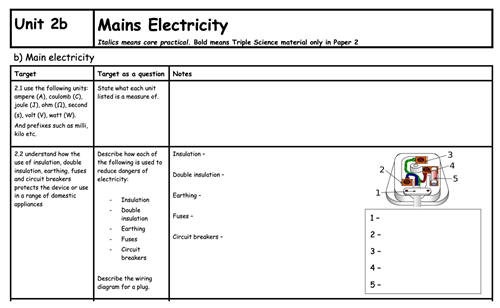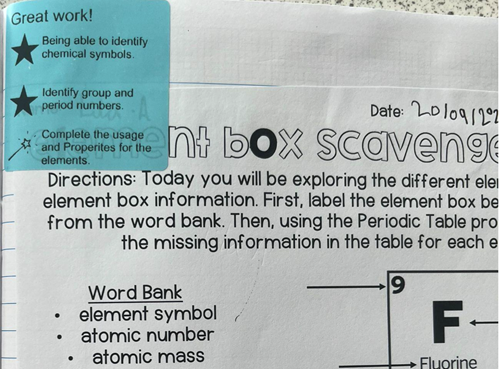Head of Science at Arcadia School Dubai, Ryan Kenny knows a thing or two about marking. In this article, Kenny analyses different methods for marking and providing feedback whilst considering the most effective and efficient techniques.
As the age-old saying goes “...in this world, nothing is certain except death and taxes” but for educators around the world, there is a third guaranteed staple: marking. The never-ending to-do list will always have 'marking' scribbled across it and for each piece marked it seems a mountain awaits in the background. There must be a better way or an easier system to manage this cycle of red pen and purple highlighters.
Within this article, I am going to discuss some of the ways I have managed to reduce my marking workload to as low as possible while still maintaining excellent student outcomes. The main takeaway is planned marking, not just the classic scheduling into my Google calendar but planned within my lessons.
Target Sheets
You don’t have to have been in education long to realise that we have a repeating cycle of innovation in the classroom. This is an example of one such idea that has come and gone over the years. Back in a new fashion, I present the target sheet.
This example shows how a student has given themselves a score out of 10 for each of the objectives. When we compare this to our digital software (Century Tech) we can see that the students start to grade themselves and start to develop their metacognitive skills.

The target sheet is as simple as it gets to provide more efficient marking and feedback. Students are given the objectives for the unit and then it is a simple tick once they have completed that objective. For our versions, we check back to these sheets before a unit, after the unit and a few weeks into revision.
There is a lot of room for improvement with these sheets however the point is that they are simple, very easy to understand and even quicker to set up. With a low set-up time, they are quick to implement into your department.
Overall Score of 6/10.
Scaffolds
Now the name of these can change and fit with whatever message you are trying to portray but the basic idea is that you are sharing a revision resource that builds throughout the unit. The way we have designed our scaffolds is that we have the objective for the unit in the first column and next to that is a question that is very specific against that objective. This gives us a clear opportunity to assess that objective, our marking and feedback can then be specific against a set objective and give clear direction and next steps for our students.

This example shows the start of the Pearson Edexcel IGCSE 9-1 Physics specification for Unit 2: Electricity. The objectives are directly taken from the specification and the questions based on IGCSE exams however adjusted to match the specific objective.
These scaffolds are very effective once the students and teachers have had a chance to use them however, they do come with a bit of set-up time. This is a prime example of the more time put in to make them correctly pays off in a more effective product in the end. When partnered with the Target sheets the scaffolds can be used as evidence for students to be able to tick off their objectives and prove they know their stuff.
Overall rating: 9/10
Built-in Feedback
Before going fully into this strategy I will admit this is one of the most time-consuming methods unless you already create your own worksheets, then this becomes a much more simple task. The idea here is to plan feedback points such as checklists into your worksheets. This means you know the marking opportunity is already present and you can simply tick the parts that students have followed and therefore any unticked boxes are the students' next steps.

The example here is for a chemistry lesson and the checklist shows the steps that students need to follow to answer the example question. The negatives to this method? There are limitations on the types of tasks or topics it will work for as some tasks can not be simplified to a checklist.
My students do enjoy these as they also provide guidance during the lesson so has the added benefit of supporting students while reducing that marking workload.
Overall rating: 6/10
Marking Labels
One issue I found when I first started teaching was finding the space to write my feedback to students, one of the early innovations I found was marking slips. The basic concept is that your marking is filled on a separate piece of paper and stuck over the top of the student's work, glued at one side so it can be lifted to see the work underneath. This idea developed into Marking Made Easy, a company that I and a colleague set up. We are now using portable thermal printers to directly print feedback onto labels for students to stick into their books. The key time saver is that you can dictate the feedback on your phone orally, and it will print directly onto the sticker. This saves both time and your writing hand. The pre-made template makes it easier to keep feedback consistent across multiple teachers.
You don’t need to be using the printers to implement this idea, a pack of stickers and a pen will give you a similar impact.

Overall rating: 9/10
Some of these methods will work better than others depending on your specific circumstances, some classes will struggle to be able to fill in a target sheet and you may need to put in more time to train them to be able to confidently assess themselves. I found that the earlier these methods were implemented then by mid-way through the year it became second nature to my students. The fasted impact was the built-in feedback, this made my lessons easier as students had guidance built into the worksheet and made my marking less time-consuming while more impactful as there was a direct link between the checklist and the task. The best method if you have the time to spend is the scaffold sheets, these do take time to make and implement into your curriculum however once they are made then you can use them as part of your homework, assessment, lessons, revision… the list goes on.
I hope you can take something away from this article even if you don’t like any of these methods at least you now know not what to try.
- - - - - - - -
** Not registered yet? Create your free profile here and add a response below **
To share your story, thoughts or ideas with the ISN community, please send your article draft directly to our editorial team here, or email us at [email protected]

